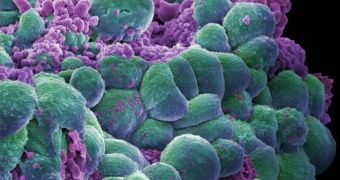Experts from the US Department of Energy's (DOE) Argonne National Laboratory (ANL) have recently managed to obtain a new type of particles, that could prove to be very efficient in destroying cancer cells. The team says that their nanoscale discs can literally shake cancer cells to death, potentially providing a new avenue of research for oncologists and other researchers. Still, the new method is years from practical implementation, the experts highlight.
Thus far, trials have only been conducted in petri dishes in the tightly-controlled confines of biological laboratories. The nanodiscs are aimed at destroying brain cancer cells specifically. This is extremely important, doctors say, because this particular type of cancer is extremely difficult to treat, evolves very fast, and is generally lethal in very high percentages. Having a method that would at least halt its development would mean a lot for the thousands of people currently suffering from the condition.
The tiny disc the team created are made of iron-nickel, but are plated with gold, and therefore magnetic. The small structures are coated with a layer of cancer-specific antibodies. This means that the nanoparticles can be injected anywhere in the human body, and still find their way to the diseased cells. However, the location of the original shot determines how fast the nanodiscs make their way to their targets. This is not the first method of fighting cancer to look at nanoscale designs, but it brings a series of innovations that other methods do not carry.
For instance, after the discs bind to their cellular targets, they remain inactive for specific periods of time. They only activate when researchers begin applying a small alternating magnetic field on the area of the tumor. At that time, they begin to oscillate strongly, and thus transfer the energy to the cells they are bound too. This forces all cells in the tumor to go into a state called “sudden death”, basically destroying them. The scientists don't know exactly what happens when the cells oscillate, but they believe that the violent shaking may be disrupting the cellular membrane.
This is known to trigger a series of cellular signals and events, that have the ultimate consequence of destroying whichever cell is targeted. “We are very excited about this melding of materials and life sciences, but we are still in the very early research stages. We are planning to begin testing in animals soon, but we are several years away from human trials. Everything is still experimental,” says ANL materials scientists Valentyn Novosad, quoted by LiveScience.

 14 DAY TRIAL //
14 DAY TRIAL //